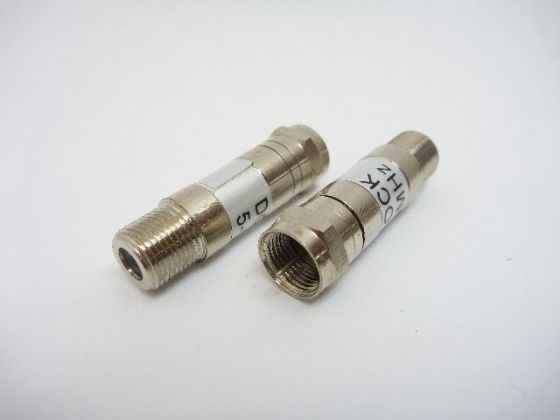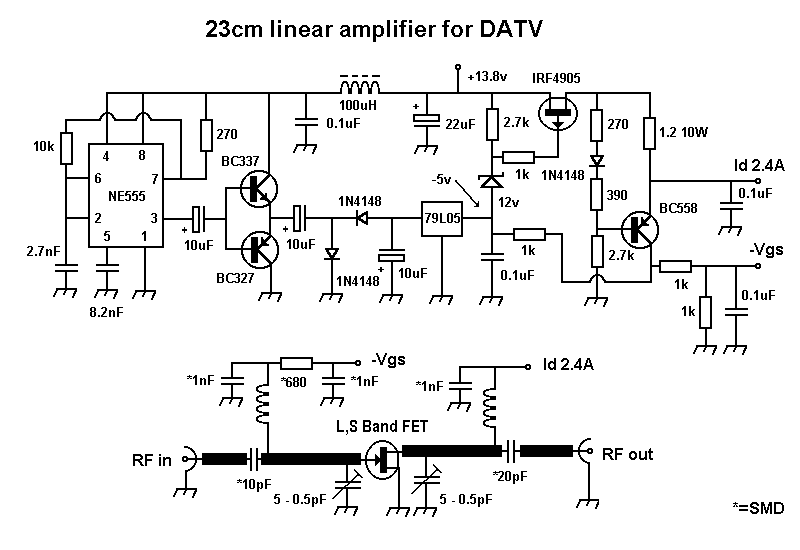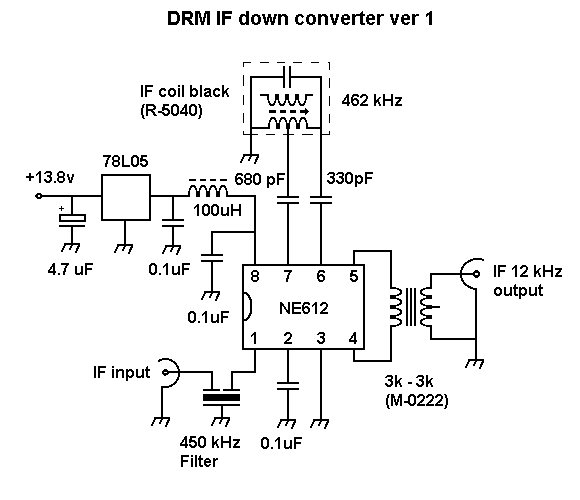Receiving DATV
with Satellite TV equipment
Receiving DATV
with Satellite TV equipment
Background
ATV in Auckland started out on the 70 cm using AM modulation and all contacts were made via simplex. The receivers were modified UHF tuners pulled down to 443.25 MHz with homemade pre-amps. From these experiments it soon became self evident that a repeater was required. The fist repeater configuration had a 443.25 MHz input with 610 MHz output, later change to channel E39 to fit within the newly work out UHF television band plan.
With ongoing upgrades over the years and improvements such as a second input added on the 23 cm band, increased RF power and performance. ATV became more visible this mode could reach out to the public unlike any other mode could. This ment that ATV soon provided a good advertisement tool. With these continuing band changes affecting things this has made this area of our hobby very innovative and at cutting edge technology. Unfortunately there are a number of down sides to this:
1/ ATV is very much based around home contraction, so a basic understanding of electronics is advantage.
2/ The cost factor involved in setting up can be a problem for some.
3/ Ham radio operators find change difficult to deal with, they rather walk away then face these challengers.
In summery change is good for innovation but not for ongoing activity. But mixture of both can provide opportunities that can be explored in the hobby.
With the change over to FM modulation we soon discovered the advantages of FM, this is when we started using Satellite equipment. Currently with the older FMTV there are two way of receiving signals one is with kitset board with a L-band tuner module, or the other way is by using a modified analog satellite settop box. Where digital is next step in technology in the same way that FM was from AM.
Equipment for DATV
As you will see the layout and components much the same as they were for analog. For receiving digital signals is not that hard to do, with Freeview receiver coming widely coming available on market. All bands above 23 cm are using the same digital format as used by Satellite providers (DVB-S). The IF range of these settop box’s goes from 950 to 2150 MHz, the 23 cm band is 1240 to 1300 MHz. As you can see the IF range covers this frequency range.

Here is a picture a Strong Satellite Settop box
Satellite in-line amplifiers also can be used as pre-amps with a DC blocker. The noise figure is not that good, it’s some where in range of 5 to 6 dBs but this is better no pre-amp.

In-line amplifier |

DC-blocking F-connectors |
Loop Yagis are used as TX and RX aerials on numbers of bands 23, 13 and 9 cm. A Loop Yagi is nothing more then Quod with round elements. These antennas are made by Directive Systems in kit set form. They can be ordered with out booms and can be contracted in less then a couple of hours.

Block diagram layout

Receive converters for ATV band I use S, C and Ku band LNB’s, with a modified Ku band with a 9 GHz local oscillator. On the 3 cm (10 GHz) band Ku Satellite dish’s work very well, by mounting this LNB into the feed point.

Another useful peace of Satellite equipment is a DiSEqC switch, with this device lets you select between four switchable inputs. As in the example below.

DATV repeater inputs
For a number of years now the Auckland ATV repeater has had a operating digital input. Ralph ZL1TBG and myself have both made good use of this, with been digital the received signal comes in at P5 quality. Therefor any noise that is seen is likely to pick up on receive side. The receiver layouts above will provide away of receiving simplex contacts, monitoring your home station setup and any repeater outputs in your area on these bands.
DATV on channel 39 with a Freeview TV
The format for the UHF TV band is DVB-T (COFDM), this very good transmission modulation system. It has three levels of modulation QPSK, 16QAM and 64QAM. Unlike television broadcasters ATV will be using the Mpeg2 format by doing this we can keep the upgrade cost to a minim. There is no need to run at the modulation level of 64QAM, by doing this we can also improve our signal to noise performance.
Digital Television
|
Digital Video Broadcast (DVB) |

|
|
There are two formats that are used for Ham radio. The first format is DVB-S. This uses QPSK (Quadrature Phase Shift Keying) modulation which works well on the 13 / 23cm bands. DVB-S is primarily used for satellite communications. The symbol rate can be adjusted from 3k to 45k depending on the data rate required and bandwidth available. The second is DVB-T. This uses COFDM (Coded Orthogonal Frequency Division Multiplexing) modulation designed for UHF television channels with 8 MHz bandwidth. 1705 or 6817 (2k or 8k formats) carriers are fitted into an 8 MHz channel with guard intervals in the time domain. These guard intervals are there to improve the robustness of the wanted signal against any multi-path problems. Each carrier can be QPSK or QAM (Quadrature Amplitude Modulation) modulated up 64QAM. COFDM will fit into the 70 / 50cm bands. |

|
|
The DVB system is common to all types modulation used (C, S, and T formats). So it possible to transcode between formats. A DATV repeater can simply put together with a receiver module connected to a modulator module. The receiver corrects for any errors that may be in the received data. Then the modulator re-adds in the forward error correction for the transmit side. Multiplexing of transport stems into a DVB format. Most multiplexes have a number of ASI inputs and one or two ASI outputs. The data rate is set for each of the inputs within the multiplex unit. Types of digital input could be Data, MPEG2 video & sound, or Teletext. MPEG2 encoder formats are 352 x 288 and 720 x 576. Analogue input for standard definition DATV 720 x 576 is used, in high definition, the format 1920 x 1080 is used. High definition is fed into the encoder as serial data DVI or HDSDI formats. Video files can also be streamed from your PC hard drive by plugging in a PCI to DVI or a PCI to ASI card. The DVI card could be connected to a MPEG2 encoder. An ASI card could send out as DVB formatted serial data to the multiplex unit or direct to a modulator. |

|
Available bitrates (Mbit/s) for DVB-T system in a 8 MHz bandwidth
Modulation |
Coding rate |
Guard interval |
|||
1/4 |
1/8 |
1/16 |
1/32 |
||
QPSK |
1/2 |
4.976 |
5.529 |
5.855 |
6.032 |
2/3 |
6.635 |
7.373 |
7.806 |
8.043 |
|
3/4 |
7.465 |
8.294 |
8.782 |
9.048 |
|
5/6 |
8.294 |
9.216 |
9.758 |
10.053 |
|
7/8 |
8.709 |
9.676 |
10.246 |
10.556 |
|
16QAM |
1/2 |
9.953 |
11.059 |
11.709 |
12.064 |
2/3 |
13.271 |
14.745 |
15.612 |
16.086 |
|
3/4 |
14.929 |
16.588 |
17.564 |
18.096 |
|
5/6 |
16.588 |
18.431 |
19.516 |
20.107 |
|
7/8 |
17.418 |
19.353 |
20.491 |
21.112 |
|
64QAM |
1/2 |
14.929 |
16.588 |
17.564 |
18.096 |
2/3 |
19.906 |
22.118 |
23.419 |
24.128 |
|
3/4 |
22.394 |
24.882 |
26.346 |
27.144 |
|
5/6 |
24.882 |
27.647 |
29.273 |
30.160 |
|
7/8 |
26.126 |
29.029 |
30.737 |
31.668 |

|
For more information on digital television have a look at this web site |
D-ATV.com |
Digital Radio Mondiale (DRM)

|
DRM Data DRM is designed to work on frequencies below 30 MHz. The concept of DRM is a digital replacement for AM Broadcast radio on Long Wave, Medium Wave and Short Wave bands. The digital signal on HF uses 10 kHz of bandwidth MF and LF bands are 9 kHz wide. On LF and MF broadcast bands DRM is transmitted in mode A on HF bands modes B, C, or D are used for sky wave propagation. DRM modes are design for different propagation effects. Mode A is for ground wave propagation, modes B and C are for sky wave and mode D is for near vertical intendance sky wave. The robustness of signal comes from the addition of pilot carries within the digital signal. When a DRM receiver locks on to the signal it looks at relative levels of the pilot carries. In this way you can counter the fading effects though out the pass band. Digital encoding let you encode a number of transport stems into one. Sound encoding uses mpg 4 with AAC for mono or AAC+ (SBR) for stereo. AAC+ also gives greater high-end audio frequency response. Data stems can multiplex into signal at different bit rates. Image files can also sent as compressed jpg files at different bit rates within the signal. Receiving DRM can done by converting it down to an IF of 12 kHz. The simples way to do this is modifying a broadcast receiver at the IF frequency. Most IF down converters use a NE612 mixer to do this. The 12kHz IF frequency is feed into a PC sound card in my case into the microphone input. There is two type of DRM receiver software available that can be used DRM Radio or DRM dream. DRM dream is what I am using it gives you the ability to receive analog signals as well. DRM dream |

|
Mode |
Modulation (nQAM) |
Robustness |
Nominal Signal Bandwidth (kHz) |
|||||
4.5 |
5.0 |
9.0 |
10.0 |
18.0 |
20.0 |
|||
Approx. available bit rate kb/s |
||||||||
A |
64 |
Max |
9.4 |
10.6 |
19.7 |
22.1 |
40.9 |
45.8 |
64 |
Min |
14.7 |
16.7 |
30.9 |
34.8 |
64.3 |
72.0 |
|
16 |
Max |
6.3 |
7.1 |
13.1 |
14.8 |
27.3 |
30.6 |
|
16 |
Min |
7.8 |
8.9 |
16.4 |
18.5 |
34.1 |
38.2 |
|
B |
64 |
Max |
7.2 |
8.3 |
15.3 |
17.5 |
31.8 |
35.8 |
64 |
Min |
11.3 |
13.0 |
24.1 |
27.5 |
50.0 |
56.1 |
|
16 |
Max |
4.8 |
5.5 |
10.2 |
11.7 |
21.2 |
23.8 |
|
16 |
Min |
6.0 |
6.9 |
12.8 |
14.6 |
26.5 |
29.8 |
|
C |
64 |
Max |
13.8 |
29.0 |
||||
64 |
Min |
21.6 |
45.5 |
|||||
16 |
Max |
9.2 |
19.3 |
|||||
16 |
Min |
11.5 |
24.1 |
|||||
D |
64 |
Max |
9.2 |
19.5 |
||||
64 |
Min |
14.4 |
30.6 |
|||||
16 |
Max |
6.1 |
13.0 |
|||||
16 |
Min |
7.6 |
16.3 |